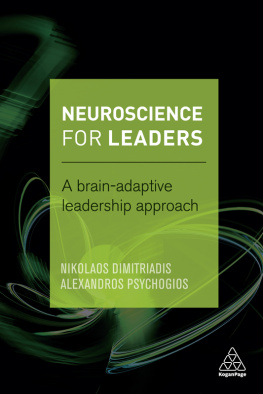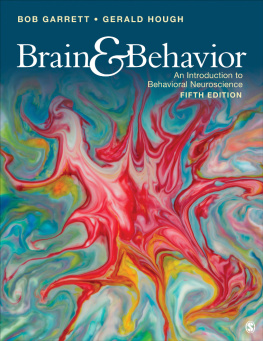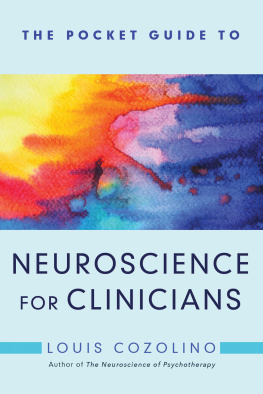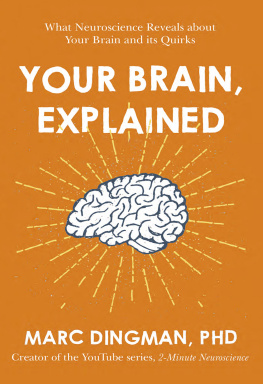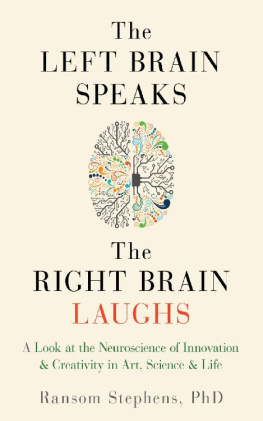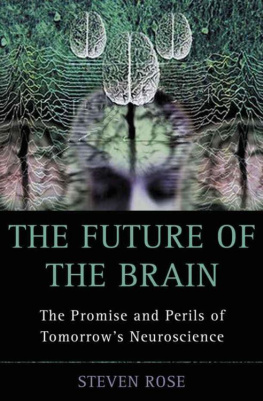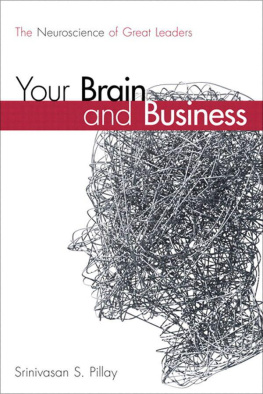J ay would like to thank in memory Eliot Stellar and George Wolf, wise neuroscientists and mentors, and many other colleagues, some long gone. He also thanks many living colleaguestoo many to mentionin the neurosciences. But here are some: Kent Berridge, Harvey Grill, Joe Herbert, Joe LeDoux, Bruce McEwen, Ralph Norgren, Jeff Rosen, Larry Swanson, Peter Sterling, and many not noted here. He feels so fortunate to have participated in neuroscience with them. Jonathan is grateful in memory to John J. McDermott, who introduced him to the work of William James, the grandfather of modern neuroscience, and to the other philosophical mentors of his youth, Peter Caws, Richard S. Rudner, and Evelyn U. Shirk.
For several years, this project has provided us with a rewarding dialogueand a certain local Washington, DC, bakery and coffeehouse with two regular customers. We are especially grateful to our editor, Eric Schwartz, for his confidence that we could write a different kind of book about the brain. Each of our spouses is no doubt grateful that we provided each other with someone else to talk with about our work, but we are more grateful to them. Our kids, two sets of two, will just have to inherit another book.
We both claim close connections to the University of Pennsylvania, where Jay was a graduate student and faculty member and Jonathan is a faculty member. This book is dedicated to our many supportive friends and colleagues at Penn.
ALSO BY JONATHAN D. MORENO
Impromptu Man: J. L. Moreno and the Origins of Psychodrama, Encounter Culture, and the Social Network
Mind Wars: Brain Science and the Military in the Twenty-First Century
The Body Politic: The Battle Over Science in America
Undue Risk: Secret State Experiments on Humans
Deciding Together: Bioethics and Moral Consensus
COAUTHORED BOOKS
Ethics in Clinical Practice (with Judith Ahronheim and Connie Zuckerman)
Discourse in the Social Sciences: Strategies for Translating Models of Mental Illness (with Barry Glassner)
ALSO BY JAY SCHULKIN
Reflections on the Musical Mind: An Evolutionary Perspective
Naturalism and Pragmatism
Effort: A Behavioral Neuroscience Perspective on the Will
Bodily Sensibility: Intelligent Action
Roots of Social Sensibility and Neural Function
The Neuroendocrine Regulation of Behavior
COAUTHORED BOOKS
Milk: The Biology of Lactation (with Michael L. Power)
The Evolution of Obesity (with Michael L. Power)
T his book has highlighted just a fragment of the rich array of discoveries and problems in neuroscience. We have tried to give a view that is balanced with both excitement and caution. We are excited about this age of neuroscience in which we find ourselves, yet we dont want to understate the difficult road ahead, in terms both of the challenges of gaining new knowledge about the brain and of the ethical issues that will be encountered along the way. Moreover, we have wanted to place neuroscientific considerations in the context of the whole brain, especially in the context of our evolution, both biological and cultural.
Ralph Adolphs outlined some of the outstanding questions in neuroscience:
- Problems that are being solved, such as neural design and function or computational expression.
- Problems that we should be able to solve in fifty years or so, including circuit organization, in vivo clarity of connectome, and site-specific and neuronal-specific organization whole-brain maps, and brain decision-making.
- Problems whose solutions are far down the road, including diverse computational systems in the brain and their interaction, and the expression of behavior.
- Problems we may never solve, such as exactly how the brain computes or the design principles of specific and general capabilities, as well as big questions that may linger without solution.
We have called attention to the fact that the brain is not only in the head but also is expressed throughout the body and through neuronal interactions within its ecological and social milieu. In appraising events, the brain reaches into the peripherythe heart, the gut, and everywhere else. Aristotle mistook the heart as the organ of thought, perhaps because it seems to register reactions to events in such a dramatic way. Then it became identified more strictly with emotionality and divorced from thought. But, even metaphorically, the heart is not on one side and the brain on the other. All sorts of information molecules inhabit and manage the heart and the brain. The vagus nerve sends direct signals to and from the heart in the organization of action and in making sense of the world we are in. The body reaches out as tentacles in understanding the larger environment. Our concept of epineuromics emphasizes the larger environment in which to understand the neural sciences, the supporting environment in which the brain functions and without which it could never have been created.
In the end, the study of the brain is about us and our epistemic endeavors, our struggle to understand, manage, and flourish. In that sense, the experimental study of the brain is special. It is not just any organ. Rather, the intense focus on the brain illustrates how much of its substance is about what makes human beings human. Those of us who believe that the human experience has intrinsic valuefor all its finitude, tragedy, and comedyneed to appreciate the brain in context.
I n Seattle, Washington, scientists transmit signals from one persons brain to another over the internet to control the second persons hand motions.
In Berkeley, California, researchers collect brain signals from people watching a video and reconstruct the images in a computer-generated movie.
In Zurich, Switzerland, neuroscientists give people extra shots of a brain chemical called oxytocin to make them more trusting in social situations.
In Tokyo, Japan, tiny electrical stimulation is shown to help stroke patients recover their ability to swallow.
These twenty-first-century experiments are striking in many ways, and they often use new technologies to create or to measure an effect on the brain. But provocative brain experiments arent new, and they neednt be high tech. In 1963, armed only with a radio-equipped transmitter, an audacious Spanish neuroscientist named Jos Delgado stepped into a bullring in Cordoba to face an animal bred to fight. As the bull charged at Delgado, he pushed a button on the device he called a stimoceiver, which activated an electrode implanted in the bulls brain, causing it to stop dead in its tracks, but it was otherwise unharmed. Not satisfied to perform this feat of scientific courage once that day, Delgado conducted the same demonstration with bull after bull. Each one halted in its tracks as the button was pushed.
NO BULL
Delgado, a professor in New Haven and Madrid, was a colorful and controversial pioneer of brain stimulation by electrical impulses. Delivered to regions of the brain like the hypothalamus, these subtle charges could alter, stop, or excite behavior. For years, Delgado worked on placing electrodes in the brain as a means of controlling thought and action. Experimenting with various species, he was particularly interested in controlling violence by stimulating brain regions. Much of that research would never be allowed now, particularly his work with chimpanzees, and the experiments played into ideas about brainwashing and mind control that were so prevalent during the Cold War. A front-page story the New York Times called Delgados bullring experiment the most spectacular demonstration ever performed of the deliberate modification of animal behavior through external control of the brain. Delgado went so far as to patent an electronic system that he and his colleagues invented for the activation or inhibition of electrical activity in the brain.
Next page


